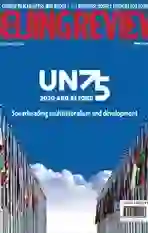A BETTER FUTURE FOR ALL
2020-10-22

Beate Trankmann, Resident Representative of the United Nations Development Programme (UNDP) in China, tells Beijing Review about the cooperation between the UNDP and China and what the results mean for the world. This is an edited excerpt of the interview:
Beijing Review: What is going to be the focus of development in the post-novel coronavirus pandemic period?
Beate Trankmann: The world that emerges post-novel coronavirus disease (COVID-19) will be very different and how we respond and adapt during this period will impact the future direction of our planet. As such, it is absolutely essential that we take advantage of this moment to reemphasize the growing urgency of shifting to a low-carbon economy.
The costs of ignoring the rules of climate science were laid bare by COVID-19. A warming climate damages the natural environment, shrinking wildlife habitats and forcing animals and humans into closer contact. This makes it more likely that viruses will jump across species.
If climate change increases, the risk of future pandemics increases with it. As we recover from the pandemic, we must also heed the warnings of our warming world for greater resilience from future shocks stemming from a changing climate.
The most effective way to do this is to adopt a“new normal” that is compatible with the boundaries our planet has set. This calls for ideas, solutions, and models that are both sustainable and comprehensive, connecting the social, ecological and economic aspects of development.
The unprecedented global response to COVID-19 has already proven that this new normal is possible. The habits that quickly developed during the pandemic—such as working from home, contact-free services, and reduced travel—demonstrates that we can operate under a low-carbon, green model. For the fi rst time in world history, we even saw a virtual Group of 20 summit.
We should build upon these habits and mainstream them into government and organizational policies, as well as our own behavior. Such changes should be accompanied by further incentives for renewable investments, ensuring a future that is lowcarbon, resource efficient, socially inclusive and less vulnerable.
China is well-positioned to provide global leadership in this effort. The country is at the forefront of solar technology and low-carbon transportation, including high-speed rail, bike sharing, and electric vehicles. It has one third of the worlds wind power, a quarter of its solar capacity, six of the top 10 solar panel manufacturers and four of the top 10 wind turbine makers.
During the pandemic, China has shown the benefits of embracing digital technology. Indeed, its digital economy has been a major factor in its ability to shield citizens and companies against the impact of COVID-19 lockdowns, while bolstering the economy.
In the push to adopt green models, we must also remember to support the most vulnerable and make sure to leave no one behind. For example, while the development of digital infrastructure and online services shows great potential for lowering emissions without sacrificing economic growth, not everyone has equal access to technology, nor are they equally capable of using it.
Despite China leading the world in installed bandwidth thanks to massive investments into information technology infrastructure, a digital divide remains between rural and urban citizens. Internet penetration in Chinese urban areas is 76.5 percent while that in rural areas is 46.2 percent. Reducing these types of inequalities will be critical to ensure that everyone can enjoy the long-term benefits of a greener, digitized economy.
The transition to a green economy must be as inclusive as it is environmentally conscious.
How is the UNDP working with China to tackle climate change?
During the last 10 years we have implemented 15 projects in China. Our climate change-related work is mainly funded through the Global Environment Facility (GEF), one of the biggest multilateral trust funds to address global environmental issues. Our work also encompasses projects funded by international development partners, the private sector, and through Chinese local government co-fi nancing.
A prime example of the UNDP and China working together to tackle climate change is our provincial climate change program (2010-14), which assisted in the establishment of climate change divisions within the provincial development and reform commissions in 31 provinces, municipalities and autonomous regions across China.
Other initiatives that have been contributing to fighting climate change seek to transform industries and sectors, such as our project on phasing out energy-inefficient incandescent lamps. It introduced energy-saving lamps and helped transform local lighting manufacturing to produce energy-efficient appliances for public spaces, such as LED lamps, resulting in reductions of carbon dioxide emissions by 4.4 million tons.
We have also been engaged in transforming the construction sector and introducing energy-efficient building materials and production methods. In particular, we introduced energy-efficient bricks and production technologies to rural brick-making plants that supply rural housing projects. By better insulating houses, not only did the efficiency reduce peoples heating bills, it also led to a cumulative reduction in carbon dioxide emissions amounting to 1.6 million tons.
For almost two decades, the UNDP has promoted hydrogen-based clean energy solutions in China. Together with the Ministry of Science and Technology, the UNDP is currently supporting the development and commercialization of hydrogen fuel cell vehicles in partnership with the GEF.
The UNDP also assisted in the creation of Chinas national emission trading system, which is the largest emission trading scheme in the world. In Zhejiang, home to some of the largest logistics companies, we have furthermore worked to green the logistics industry, combining operational efficiency, environmental friendliness and energy effi ciency for more sustainable logistics operations.
How has the UNDP contributed in poverty alleviation work in China?
Since the early beginning of establishing our office here in 1979, the UNDP has been a partner in Chinas development and poverty alleviation has been central to our cooperation with China.
Our contributions fall under three main categories: i) providing technical and policy advisory services, ii) scaling up sustainable solutions for development, and iii) sharing the best practices with China as well as between China and other developing countries.
For example, the UNDP has supported China in transitioning from economic growth-centered measurements of development to a multifaceted system to measure developmental progress that includes dimensions such as social protection and environmental sustainability. As a result, Chinas 12th Five-Year Plan(2011-15) included 23 development indicators that were developed with technical advice from the UNDP.

Our technical task force program is an example of co-creating a blueprint for a sustainable development solution that subsequently can be adopted by the government to take it to scale. This was established to propel farmers into the 21st century by linking them with environmentally friendly and locally relevant technologies, thereby not only increasing their income, but also connecting them to markets. Since 2008, 1 million farmers have benefited each year, with a 10-percent average annual increase to their incomes.
Finally, to facilitate international exchanges of best practices, the UNDP has helped establish the International Poverty Reduction Center in China aimed at creating a global knowledge hub on poverty reduction. The center has provided government offi cials and experts from developing countries all over the world with training and expertise on poverty reduction and sustainable development.
What does the eradication of absolute poverty in China mean for the world?
Chinas size and scale mean everything that it achieves also has global ramifi cations. This applies to the progress made domestically on human development. Chinas success in eradicating poverty over the last 40 years has been historic and is making a signifi cant contribution toward the achievement of Sustainable Development Goal (SDG) 1—ending poverty worldwide.
While every country context is different, Chinas targeted, bottom-up approach to poverty alleviation does offer valuable lessons for the global fi ght against poverty. Importantly, it has taken a long-term perspective with sustained political commitment over decades across all levels of government and systematic investments both in terms of fi nancial and human resources.
Based on a detailed assessment of local conditions, China identifies down to the household level where the poor are, what they lack, and what they need—region by region, village by village. This has informed the design and implementation of tailor-made interventions specifi c to each county and village.
China is also increasingly engaging on the international scene and becoming an important source and driver of connectivity-related infrastructure investments and lending in many other developing countries. As a funder of development overseas, it is critical that it moves in a way that safeguards global public goods, is well aligned with the SDGs and context fi t for the needs of developing partner countries.
One particular aspect in this regard is to apply harmonized standards compatible with SDGs to development fi nancing. This then can assist in bringing in investments to the Belt and Road and other SouthSouth cooperation countries that are environmentally sustainable while also being inclusive.
